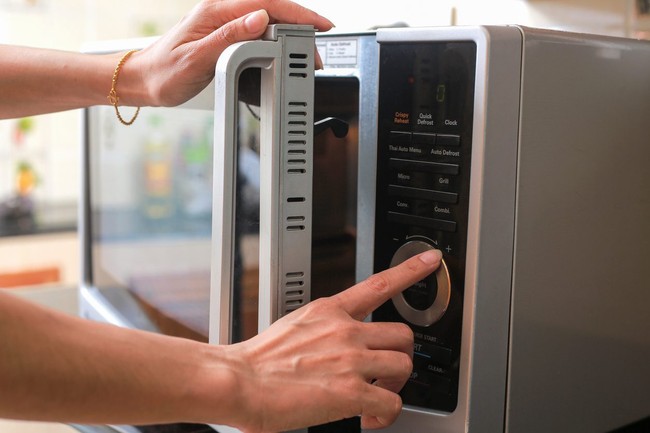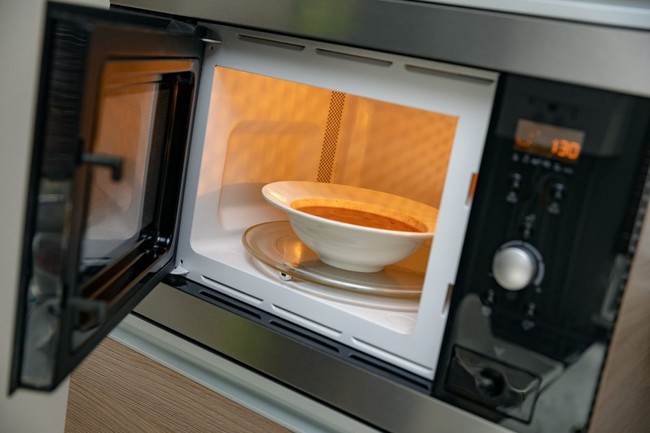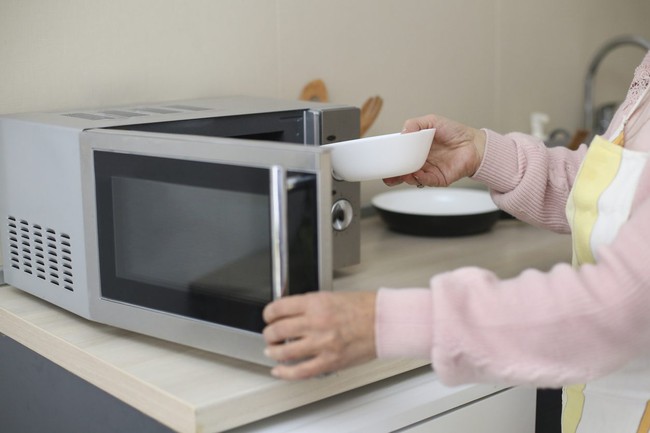Basic Principles of Using a Microwave Oven That Every Woman Should Know
In today’s fast-paced world, the microwave has become an invaluable ally for those with limited time to cook. It has now found its place in almost every household kitchen and is used for cooking, but most importantly, for quickly heating up cooked food within seconds.
The speed at which a microwave operates is determined by a special type of wave that “activates” the molecules in our food, but are we really sure that it is the best cooking method besides being the fastest? How does a microwave really work efficiently? Can you really cook everything in a microwave? This article will reveal the tips and secrets of an amazing household appliance that has forever changed the way we cook.
1. How does a microwave oven work?
A microwave oven is a kitchen appliance that uses electromagnetic waves to heat and cook food. It consists of a magnetron, which generates microwave radiation, and a cavity or cooking chamber, in which the food is placed.
When the microwave is turned on, the magnetron produces high-frequency electromagnetic waves, which are then directed into the cooking chamber. These microwave waves are absorbed by the water molecules present in the food. As the water molecules absorb the waves, they vibrate rapidly, generating heat. This heat is then transferred to the surrounding food, cooking it evenly.
The microwaves used in the oven are of a specific frequency that is absorbed by water molecules, but not by most other substances. This is why microwave ovens are most effective at heating and cooking food that contains water, such as vegetables or meat, rather than dry items like bread or crackers.
The cooking time in a microwave oven is much shorter compared to traditional methods like baking or boiling, as the microwaves can penetrate the food and cook it from the inside out. However, it’s important to note that not all foods can be cooked in a microwave, as some may not heat evenly or may become rubbery in texture.
Overall, a microwave oven works by using electromagnetic waves to excite water molecules in food, generating heat and cooking the food quickly and efficiently.
Unlike traditional ovens where heat is conducted and radiated, a microwave oven generates heat from the impact of waves on the water molecules present in the food. These molecules are “agitated” by the microwave, initiating movement and can reach high temperatures while heating or cooking the food. This cooking method helps to save time: all the heat energy remains within the food and does not dissipate.

2. Is it really good to defrost food in the microwave?
Defrosting food in the microwave is a common practice in many households. It offers a convenient and quick way to thaw frozen food, saving time and effort. However, there are some considerations to keep in mind before using this method.
Firstly, it is important to ensure that the food is properly packaged when defrosting in the microwave. This helps to prevent the food from becoming contaminated or drying out during the defrosting process. Using microwave-safe containers or wrapping the food in microwave-safe plastic wrap can help maintain the quality of the food.
Secondly, it is recommended to use the appropriate defrosting setting on the microwave. This setting is specifically designed to defrost food in a safe and efficient manner. It is important to follow the manufacturer’s instructions and guidelines for defrosting various types of food.
Additionally, it is crucial to monitor the defrosting process closely. Microwave ovens can heat food unevenly, leading to potential hot spots. This can result in partially cooked or overheated areas in the food. To ensure even defrosting, it is recommended to rotate or stir the food periodically during the defrosting process.
It is worth noting that not all foods are suitable for defrosting in the microwave. Delicate items such as cakes or pastries may lose their texture and become soggy. It is best to refer to specific defrosting guidelines for different types of food to ensure the best results.
In conclusion, defrosting food in the microwave can be a convenient option, but it is important to follow proper guidelines and precautions to ensure safe and optimal results. By taking the necessary steps and using the appropriate settings, you can defrost your food efficiently without compromising its quality.
In addition to reheating pre-cooked meals or cooking dishes from scratch, microwaves are commonly used for defrosting food in a matter of minutes: you will be surprised to know that this is actually a bad habit.
In fact, according to some studies, defrosting too quickly can promote the growth of bacteria naturally present in meat and fish: the freezing process tends to destroy most of these bacteria, however, if “awakened” too quickly, bacteria can multiply and cause uncomfortable stomachaches, if not worse.
So how do you thaw food not too slowly and be beneficial to our health? It’s simpler than we think: experts talk about the “cold chain” or a process in which food gradually undergoes increasing temperatures: the safest way to thaw food is to put them in the refrigerator for them to soften gradually. Also, you should note: never refreeze thawed food, you risk “awakening” double the bacteria in that food.

3. Which foods can be heated in a microwave?
In a microwave, there are various types of food that can be conveniently heated for a quick meal or snack. Some common examples include:
1. Leftovers: Leftover meals from previous cooking sessions can be easily reheated in a microwave. Whether it’s last night’s pasta, chicken, or stir-fry, the microwave can quickly warm them up to enjoy again.
2. Soup and stews: A bowl of hearty soup or a delicious stew can be easily heated in a microwave. Just pour the desired amount into a microwave-safe bowl and heat it for a few minutes until it reaches the desired temperature.
3. Frozen dinners: When pressed for time, frozen dinners can be a convenient option. Many frozen meal options are specifically designed for microwaving, providing a quick and fuss-free meal solution.
4. Beverages: Whether it’s a cup of coffee, tea, hot cocoa, or even a mug of soup, beverages can be easily and quickly heated in a microwave. Just remember to use a microwave-safe container and heat it in short intervals to prevent any accidents.
5. Popcorn: Microwave popcorn is a popular snack option that can be easily prepared in the microwave. Simply place the pre-packaged popcorn bag in the microwave and follow the instructions for a delicious and freshly popped treat.
It’s important to note that while the microwave is a convenient tool for heating certain foods, it may not be suitable for all types of dishes. Foods with a high fat or oil content, such as fried foods, may not heat evenly and may become soggy or splatter. Additionally, foods with a breaded coating may lose their crispy texture in the microwave. It’s always best to refer to the manufacturer’s instructions or use common sense when deciding which foods to heat in a microwave.
What if we can cook as well as microwave reheating, surely it will bring simple, nutritious and delicious meals? No matter what you want to cook in the microwave, always pay attention to using the right container to avoid ruining the food. In the microwave, you can cook vegetables (except for green leafy ones) and sauces, be careful not to tightly seal the container, meat (beef, pork or stew) will be especially tasty and tender thanks to cooking without fat.

4. Foods that cannot be heated in the microwave
Microwave ovens are considered a magical tool that solves all our problems: but not all types of food can be cooked in a microwave. Here are the foods that should not be put in the microwave and the reasons why:
Chicken meat: White meat can contain some bacteria that cannot always be completely eliminated when cooked in a microwave; it is better to choose to cook in a traditional way, which may take longer but will be more effective.
Potatoes: If you want to heat up cooked potatoes, the microwave is not the best method to use. In fact, at room temperature, potatoes can develop Clostridium botulinum bacteria that microwave magnetic waves cannot eliminate. It is best to use a skillet, oven, or air fryer instead.
Rice: Rice contains a significant amount of starch, which means that it should be eaten immediately or stored in the refrigerator to prevent it from turning sour. In fact, if left at room temperature, rice will become a fertile ground for the growth of bacteria that even a microwave cannot defeat.
Types of Green Leafy Vegetables: Green leafy vegetables (such as spinach, kale…) contain nitrate which is not harmful to our body itself, however, these molecules can become carcinogenic when exposed to electromagnetic waves. So it is better not to cook them in the microwave.
Breast milk and food for infants: The increase in the movement of molecules present in breast milk can degrade some nutritional properties of the milk.
Chili Pepper: Unfortunately, if cooked or heated in the microwave, chili peppers can produce toxins and become harmful substances for our bodies.

5. Which food container cannot be placed in a microwave?
Currently on the market, we can easily find suitable containers for cooking or reheating our meals in the microwave. However, always remember the materials that should never be used in the microwave:
Firstly, there are metal containers, when placing this type of container in the microwave, electromagnetic waves will reflect back leading to damaging the interior compartment of the oven.
It is also not advisable to use low-quality plastic containers as they can release harmful substances into our bodies under the influence of electromagnetic waves.
Finally, but equally important: do not use paper boxes as they can catch fire, except for food packaging boxes that are pre-made and clearly labeled on the packaging as microwave-safe.
The post https://meo.tips/tips/basic-principles-of-using-a-microwave-oven-that-every-woman-should-know/ appeared first on Meo.tips.
View more from Meo.tips:
Nhận xét
Đăng nhận xét